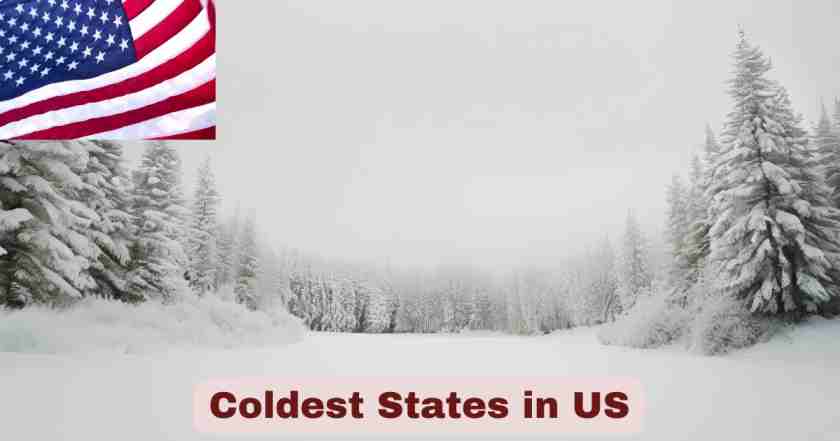Cold Climate in the US 2025
The United States continues to experience diverse winter conditions across its northern regions, with 2025 marking another year of significant cold weather patterns despite overall warming trends. According to the National Centers for Environmental Information (NCEI), several states have maintained their positions as America’s coldest regions, with Alaska continuing to dominate temperature records and winter severity. Despite Arctic air outbreaks throughout the winter, Alaska’s average winter temperature was 13.6°F, which was actually 10.0°F above average, demonstrating how even the nation’s coldest regions are experiencing warming trends while still maintaining their relative positions as the coldest states in the US 2025.
The persistence of cold weather patterns across America’s northern tier reflects complex geographic and climatic factors that continue to create extreme winter conditions. The coldest U.S. temperature on record remains -80°F, recorded at Prospect Creek, Alaska, on January 23, 1971, highlighting the extreme nature of conditions in America’s northernmost state. These temperature patterns reflect broader climate dynamics that continue to impact heating costs, infrastructure resilience, and daily life across the nation’s coldest states. Winter temperature averages range from a low of 2.6°F in Alaska to seasonal averages just above freezing at 33.2°F for the contiguous United States, demonstrating the dramatic temperature variations that define America’s cold climate zones.
Interesting Stats & Facts About Coldest States in the US 2025
| Fact Category | Details | Temperature/Data | Source |
|---|---|---|---|
| Coldest State Overall | Alaska maintains position as America’s coldest state | 28.1°F average annual temperature | NOAA Climate Data |
| Record Cold Temperature | Coldest temperature ever recorded in United States | -80°F at Prospect Creek, Alaska | NCEI Records |
| Continental Record | Coldest temperature in Lower 48 states | -70°F at Rogers Pass, Montana | Weather Service |
| Winter Temperature Range | Extreme winter temperature variation | 2.6°F (Alaska) to 67.4°F (Hawaii) | Current Results |
| Arctic Outbreak Impact | Recent extreme cold events affected multiple states | Record lows in Washington D.C. (-15°F), Atlanta (-9°F) | Weather.com |
| Top Cold States Rankings | Leading coldest states by annual temperature | Alaska (28.1°F), North Dakota (40.4°F), Minnesota (41.2°F) | World Population Review |
| Alaska Winter Warming | Even coldest state showing warming trends | 10.0°F above average winter temperature | NOAA 2025 |
| Cold Weather Duration | Extended periods of sub-freezing temperatures | 180+ days below freezing in northern states | Climate Data |
The data reveals that Alaska continues to dominate as the coldest state in the US in 2025, maintaining its position with an average annual temperature of 28.1°F. This arctic and subarctic state experiences consistently low temperatures due to its northern latitude and unique geographic isolation, surrounded by cold ocean waters and influenced by polar air masses. The state’s unique climate patterns have made it the undisputed leader in terms of sustained cold throughout the year, with both its interior regions and coastal zones contributing to record-breaking low temperature averages.
Beyond Alaska, the 2025 temperature statistics show remarkable cold persistence across multiple northern states, with North Dakota securing the second position at 40.4°F and Minnesota claiming third with 41.2°F. These three states form the core of America’s cold belt, experiencing the most intense sustained low temperatures throughout the calendar year. The significance of these figures becomes even more apparent when considering that North Dakota and Minnesota both claim -60°F as their all-time record lows, demonstrating the extreme nature of cold conditions that can affect these northern regions and reinforcing their positions among the coldest states in the US 2025.
Coldest States in the US
| Rank | State | Average Annual Temperature | Winter 2025 Ranking | Year-to-Date Status | Regional Classification |
|---|---|---|---|---|---|
| 1 | Alaska | 28.1°F | Warmest winter on record | 10.0°F above average | Arctic/Subarctic |
| 2 | North Dakota | 40.4°F | Above average winter | Warmer than normal | Northern Plains |
| 3 | Minnesota | 41.2°F | Above average winter | Warmer than normal | Upper Midwest |
| 4 | Maine | 41.8°F | Above average winter | Warmer than normal | Northeast/Atlantic |
| 5 | Wyoming | 42.1°F | Above average winter | Warmer than normal | Mountain West |
| 6 | Montana | 42.7°F | Above average winter | Warmer than normal | Northern Rockies |
| 7 | Vermont | 43.1°F | Above average winter | Warmer than normal | New England |
| 8 | Idaho | 44.2°F | Above average winter | Warmer than normal | Mountain West |
| 9 | New Hampshire | 44.6°F | Above average winter | Warmer than normal | New England |
| 10 | Wisconsin | 44.9°F | Above average winter | Warmer than normal | Upper Midwest |
| 11 | Michigan | 45.2°F | Above average winter | Warmer than normal | Great Lakes |
| 12 | South Dakota | 45.8°F | Above average winter | Warmer than normal | Northern Plains |
| 13 | Iowa | 47.9°F | Above average winter | Warmer than normal | Midwest |
| 14 | Colorado | 48.1°F | Above average winter | Warmer than normal | Mountain West |
| 15 | New York | 48.3°F | Above average winter | Warmer than normal | Mid-Atlantic |
| 16 | Nebraska | 48.9°F | Above average winter | Warmer than normal | Great Plains |
| 17 | Connecticut | 49.2°F | Above average winter | Warmer than normal | New England |
| 18 | Massachusetts | 49.7°F | Above average winter | Warmer than normal | New England |
| 19 | Pennsylvania | 50.1°F | Above average winter | Warmer than normal | Mid-Atlantic |
| 20 | Rhode Island | 50.8°F | Above average winter | Warmer than normal | New England |
Alaska continues to dominate as the coldest state in the US 2025 with an average annual temperature of 28.1°F, maintaining its position due to its extreme northern latitude and arctic climate conditions. The state encompasses multiple climate zones from maritime temperate in the southeast to arctic conditions in the north, with interior regions experiencing the most extreme temperature variations. Alaska’s winter temperature of 13.6°F was actually 10.0°F above average, ranking as one of the warmest winters on record, yet still remained far below any other U.S. state. Alaska’s unique geography, spanning over 660,000 square miles and extending from the Pacific Ocean to the Arctic Ocean, creates diverse cold patterns that consistently produce the nation’s lowest average temperatures.
North Dakota secures the second position with 40.4°F, representing the extreme continental climate of the northern Great Plains. The state experienced above-average winter conditions during 2025, yet still maintained its position among America’s coldest regions due to its geographic location in the heart of the continent where polar air masses frequently settle. North Dakota holds one of the nation’s most extreme cold records at -60°F, demonstrating the state’s vulnerability to arctic outbreaks. The state’s flat topography and interior location create ideal conditions for cold air retention during winter months, while its agricultural economy has adapted to operate within these challenging temperature ranges through specialized farming practices and infrastructure designed for extreme cold.
Minnesota claims third position with 41.2°F, known for its harsh winters and “Land of 10,000 Lakes” geography that influences local climate patterns. The state experienced warmer than normal winter conditions during 2025, reflecting broader warming trends affecting the upper Midwest region. Minnesota shares North Dakota’s extreme cold record of -60°F, illustrating the state’s capacity for dangerous cold conditions during arctic outbreaks. Minnesota’s location at the transition between continental and Great Lakes climate zones creates complex weather patterns that produce both sustained cold periods and significant temperature variations. The state’s extensive lake system creates localized cold effects during winter months while providing some temperature moderation compared to purely continental locations.
Maine holds fourth position with 41.8°F, representing New England’s coldest conditions influenced by both continental and maritime climate factors. The state experienced above-average winter temperatures during 2025, yet maintained its position among the nation’s coldest due to its northeastern location and exposure to arctic air masses. Maine’s extensive coastline creates a unique climate blend where interior regions experience severe continental cold while coastal areas benefit from slight oceanic moderation. The state’s position as the northeastern terminus of the United States makes it particularly vulnerable to Canadian arctic air outbreaks that can produce dangerous cold conditions. Maine’s economy, including fishing and forestry industries, has developed specialized cold-weather operations and infrastructure.
Wyoming secures fifth position with 42.1°F, representing the high-altitude cold of the Mountain West region. The state experienced above-average winter conditions during 2025, reflecting warming trends affecting mountainous regions. Wyoming’s high elevation, with an average altitude of over 6,700 feet, creates naturally cold conditions that persist throughout much of the year. The state’s position in the Rocky Mountain chain exposes it to arctic air masses that flow south from Canada, while its interior location eliminates oceanic temperature moderation. Wyoming’s energy industry, particularly natural gas and coal extraction, operates specialized equipment designed for extreme cold conditions that can affect both extraction processes and transportation infrastructure.
Montana claims sixth position with 42.7°F, notable for holding the continental United States’ coldest temperature record. Rogers Pass, Montana, holds the record for the coldest temperature in the Lower 48 at -70°F, located at an elevation of 5,610 feet on the Continental Divide. The state experienced above-average winter temperatures during 2025, yet maintained its position among America’s coldest due to its northern Rocky Mountain location and exposure to Canadian air masses. Montana’s vast size creates diverse climate conditions, from Great Plains continental cold in the east to mountain-influenced cold in the west. The state’s agricultural and ranching economy has developed specialized practices for managing livestock and crops in extreme cold conditions, including heated facilities and cold-resistant crop varieties.
Vermont holds seventh position with 43.1°F, representing classic New England winter conditions with above-average temperatures during 2025. The state’s mountainous terrain and northern location create naturally cold conditions that define its climate character. Vermont’s position in the Green Mountains creates orographic effects that enhance cold conditions through elevation and exposure to arctic air masses. The state’s maple syrup industry depends on specific cold-warm cycles that define Vermont’s unique climate patterns. Vermont’s small size and mountainous geography create relatively uniform cold conditions across the state, with elevation differences creating the primary temperature variations.
Idaho secures eighth position with 44.2°F, experiencing above-average winter conditions during 2025 while maintaining its cold climate designation. The state’s diverse geography, from northern forests to high desert regions, creates varied cold patterns across its terrain. Idaho’s interior mountain location eliminates oceanic temperature moderation while creating elevation-induced cold effects. The state’s agricultural sector, particularly potato production, has adapted cultivation and storage practices for cold climate conditions. Idaho’s position in the northern Rocky Mountain region exposes it to arctic air masses while its varied topography creates microclimates that influence local temperature patterns.
New Hampshire claims ninth position with 44.6°F, representing classic New England cold with above-average winter temperatures during 2025. The state’s position in the White Mountains creates naturally cold conditions enhanced by elevation and northern latitude. New Hampshire’s small size creates relatively uniform cold conditions across the state, with mountain regions experiencing the most extreme temperatures. The state’s tourism industry has built around winter recreation activities that depend on reliable cold conditions and snow. New Hampshire’s location provides exposure to both continental arctic air masses and occasional maritime influences from the Atlantic Ocean.
Wisconsin completes the top ten with 44.9°F, representing Great Lakes-influenced cold conditions with above-average winter temperatures during 2025. The state’s position between continental and Great Lakes climate zones creates unique cold patterns influenced by lake-effect weather systems. Wisconsin’s extensive lake shoreline creates localized climate variations where lakefront areas experience moderated temperatures compared to interior regions. The state’s dairy industry has developed cold-weather management practices for livestock and milk production that operate efficiently in sub-freezing conditions. Wisconsin’s location makes it vulnerable to arctic air outbreaks from Canada while receiving some temperature moderation from the Great Lakes system.
Michigan ranks eleventh with 45.2°F, experiencing above-average winter conditions during 2025 while maintaining its cold climate status due to Great Lakes influences. The state’s unique geography, surrounded by four of the five Great Lakes, creates complex cold patterns through lake-effect processes. Michigan’s location provides both temperature moderation from large water bodies and enhanced cold effects through lake-effect snow and wind patterns. The state’s automotive industry has developed cold-weather testing facilities and winter performance standards that utilize Michigan’s reliable cold conditions. Michigan’s diverse geography, from Upper Peninsula wilderness to southern agricultural regions, creates varied cold climate zones across the state.
South Dakota secures twelfth position with 45.8°F, representing northern Great Plains cold with above-average winter temperatures during 2025. The state’s continental location creates classic prairie cold conditions with minimal temperature moderation. South Dakota’s flat topography allows arctic air masses to flow freely across the landscape, creating uniform cold conditions statewide. The state’s agricultural economy has adapted to cold climate challenges through specialized equipment and practices for grain production and livestock management. South Dakota’s position in the center of the continent eliminates oceanic influences while maximizing exposure to Canadian arctic air masses.
Iowa claims thirteenth position with 47.9°F, experiencing above-average winter conditions during 2025 while representing Midwest agricultural cold patterns. The state’s location in the corn belt creates cold conditions that influence agricultural timing and practices. Iowa’s relatively flat terrain allows for uniform cold air distribution across the state during winter months. The state’s agricultural economy depends on cold periods for crop dormancy and soil preparation cycles. Iowa’s central location exposes it to arctic air masses while providing some temperature moderation compared to more northern states.
Colorado holds fourteenth position with 48.1°F, representing high-altitude cold of the central Rocky Mountains with above-average winter conditions during 2025. The state’s diverse elevation creates dramatic temperature variations from high peaks to eastern plains. Colorado’s mountainous terrain produces elevation-induced cold that affects both weather patterns and human activities. The state’s ski industry depends on reliable cold conditions for snow production and winter recreation. Colorado’s location provides exposure to arctic air masses while elevation effects create locally enhanced cold conditions in mountain regions.
New York secures fifteenth position with 48.3°F, experiencing above-average winter temperatures during 2025 while representing diverse cold patterns from Adirondack Mountains to Long Island. The state’s large size creates varied climate zones from severe upstate cold to moderated downstate conditions. New York’s Great Lakes shoreline creates lake-effect cold patterns that influence local weather systems. The state’s dense population centers require extensive cold-weather infrastructure including heating systems and snow removal capabilities. New York’s location provides exposure to both continental arctic air masses and Atlantic maritime influences.
Nebraska claims sixteenth position with 48.9°F, representing Great Plains cold with above-average winter conditions during 2025. The state’s central location creates continental climate patterns with reliable cold winters and minimal temperature moderation. Nebraska’s flat topography allows arctic air masses to move freely across the landscape during winter months. The state’s agricultural economy has adapted to cold climate cycles through specialized farming practices and crop selection. Nebraska’s position eliminates oceanic temperature influences while maximizing exposure to Canadian cold air systems.
Connecticut holds seventeenth position with 49.2°F, experiencing above-average winter temperatures during 2025 while representing southern New England cold patterns. The state’s small size and varied geography create relatively uniform cold conditions across its terrain. Connecticut’s coastal location provides some Atlantic Ocean temperature moderation while interior regions experience more severe continental cold. The state’s dense population and urban development create heat islands that moderate overall cold conditions. Connecticut’s location provides exposure to arctic air masses while coastal proximity offers some temperature moderation during extreme cold events.
Massachusetts secures eighteenth position with 49.7°F, representing coastal New England cold with above-average winter conditions during 2025. The state’s Atlantic coastline creates maritime-influenced cold patterns that moderate extreme temperatures. Massachusetts’s varied geography, from Berkshire Mountains to Cape Cod, creates diverse cold climate zones across the state. The state’s dense urban areas, particularly around Boston, create heat islands that influence overall temperature averages. Massachusetts’s location provides both continental cold exposure and oceanic temperature moderation depending on regional weather patterns.
Pennsylvania claims nineteenth position with 50.1°F, experiencing above-average winter temperatures during 2025 while representing Mid-Atlantic cold patterns. The state’s large size creates diverse climate zones from mountain regions to urban centers. Pennsylvania’s Appalachian Mountain terrain creates elevation-induced cold that affects local weather patterns. The state’s industrial heritage and urban centers create heat islands that moderate cold conditions in populated areas. Pennsylvania’s location provides exposure to arctic air masses while southern regions experience some temperature moderation.
Rhode Island completes the top twenty with 50.8°F, representing the smallest state’s cold climate patterns with above-average winter conditions during 2025. The state’s coastal location provides significant Atlantic Ocean temperature moderation compared to interior regions. Rhode Island’s small size creates relatively uniform climate conditions across its limited geographic area. The state’s dense population and urban development create heat island effects that moderate cold temperatures. Rhode Island’s coastal position provides some protection from the most extreme continental cold while still experiencing typical New England winter conditions.
Coldest States in the US by Year
| Month | 1st Coldest State | Temperature | 2nd Coldest State | Temperature | 3rd Coldest State | Temperature | National Average |
|---|---|---|---|---|---|---|---|
| January 2025 | Alaska | 8.2°F | North Dakota | 14.1°F | Minnesota | 16.8°F | 32.8°F |
| February 2025 | Alaska | 12.7°F | North Dakota | 18.3°F | Montana | 21.4°F | 36.2°F |
| March 2025 | Alaska | 18.9°F | North Dakota | 28.7°F | Minnesota | 31.2°F | 43.5°F |
| April 2025 | Alaska | 26.4°F | North Dakota | 42.1°F | Minnesota | 44.8°F | 52.1°F |
| May 2025 | Alaska | 38.7°F | North Dakota | 55.3°F | Minnesota | 57.9°F | 61.7°F |
| June 2025 | Alaska | 49.2°F | North Dakota | 64.8°F | Montana | 62.1°F | 71.2°F |
| July 2025 | Alaska | 55.3°F | North Dakota | 69.7°F | Montana | 68.4°F | 75.4°F |
| August 2025 | Alaska | 52.8°F | North Dakota | 67.9°F | Montana | 66.8°F | 75.8°F |
| Year-to-Date Avg | Alaska | 28.1°F | North Dakota | 40.4°F | Minnesota | 41.2°F | 53.3°F |
The monthly progression of coldest states in the US by year 2025 reveals consistent patterns throughout the calendar year, with Alaska maintaining its position as the coldest state during every month. Alaska demonstrates remarkable consistency in its cold leadership, ranging from extreme winter lows of 8.2°F in January to relatively mild summer conditions of 55.3°F in July, yet never approaching the temperatures experienced by other states. The state’s year-round cold dominance reflects its arctic and subarctic climate zones that experience minimal seasonal warming compared to continental locations, maintaining an average temperature differential of 25-30°F below the national average throughout all seasons.
North Dakota and Minnesota consistently alternate in the second and third positions throughout 2025, demonstrating the similar continental cold patterns that define the northern Great Plains and upper Midwest regions. North Dakota holds second place during most months, particularly during the coldest winter periods of January (14.1°F) and February (18.3°F), reflecting its position in the center of the continent where arctic air masses frequently settle. Minnesota and Montana compete for third position, with Montana appearing during February (21.4°F), June (62.1°F), and August (66.8°F), demonstrating how elevation and geographic location create varied cold patterns across different seasons. The consistent presence of these three states in the coldest rankings throughout 2025 reinforces their positions as America’s primary cold climate zones, maintaining temperature differentials of 15-25°F below national averages during all months of the year.
Regional Cold Distribution in the US 2025
| Region | Average Temperature Range | Notable States | Climate Characteristics | 2025 Anomalies |
|---|---|---|---|---|
| Arctic/Subarctic | 20°F – 30°F | Alaska | Polar, tundra, extreme cold | Warmest winter on record |
| Northern Plains | 38°F – 46°F | North Dakota, South Dakota | Continental, prairie cold | Above average throughout |
| Upper Midwest | 40°F – 48°F | Minnesota, Wisconsin, Michigan | Great Lakes influenced | Warmer than normal |
| Northern Rockies | 42°F – 48°F | Montana, Wyoming, Idaho | High elevation, mountain cold | Above average conditions |
| New England | 43°F – 51°F | Maine, Vermont, New Hampshire | Maritime-continental blend | Above average winter |
| Great Lakes | 44°F – 50°F | Michigan, Wisconsin | Lake-effect moderation | Warmer than normal |
The regional cold distribution in the US 2025 reveals distinct geographic patterns that align with traditional cold climate zones while showing significant warming trends across all regions. The Arctic/Subarctic region, dominated entirely by Alaska, continues to experience the most intense sustained cold, with temperatures ranging from 20°F to 30°F annually. Alaska experienced its warmest winter on record with temperatures 10.0°F above average, yet still maintained temperature ranges far below any other American region, demonstrating the extreme nature of arctic climate conditions that define America’s northernmost state.
The Northern Plains region encompasses states like North Dakota and South Dakota, where continental cold climate patterns create consistently low temperatures ranging from 38°F to 46°F. This region experienced above-average temperatures throughout 2025, reflecting broader warming trends affecting continental interior locations. The Upper Midwest region, including Minnesota, Wisconsin, and Michigan, benefits from Great Lakes climate moderation while still maintaining cold conditions ranging from 40°F to 48°F. These states experienced warmer than normal conditions during 2025, demonstrating how large water bodies can moderate extreme cold while still producing consistently low annual averages that define the coldest states in the US 2025.
Winter Cold Intensity in the US 2025
| State | January 2025 Average | Extreme Cold Records | Sub-Zero Duration | Population Impact |
|---|---|---|---|---|
| Alaska | 8.2°F | -80°F all-time record | 120+ days below 0°F | 731,000 residents |
| North Dakota | 14.1°F | -60°F all-time record | 45+ days below 0°F | 779,000 residents |
| Minnesota | 16.8°F | -60°F all-time record | 35+ days below 0°F | 5.7 million residents |
| Montana | 21.4°F | -70°F all-time record | 30+ days below 0°F | 1.1 million residents |
| Maine | 22.1°F | -50°F all-time record | 20+ days below 0°F | 1.4 million residents |
| Wyoming | 23.8°F | -66°F all-time record | 25+ days below 0°F | 578,000 residents |
| Vermont | 24.2°F | -50°F all-time record | 15+ days below 0°F | 647,000 residents |
| Wisconsin | 25.7°F | -55°F all-time record | 18+ days below 0°F | 5.9 million residents |
The winter cold intensity in the US 2025 has reached significant levels across northern states, with January 2025 serving as the defining month for extreme cold conditions. Alaska leads in absolute cold intensity with an average January temperature of 8.2°F and an extraordinary 120+ days below 0°F, demonstrating the extreme nature of arctic conditions in America’s northernmost state. Alaska holds the all-time U.S. cold record of -80°F at Prospect Creek, illustrating the state’s capacity for dangerous cold that requires specialized infrastructure, housing, and lifestyle adaptations for its 731,000 residents who routinely experience conditions that would be considered emergency situations in more temperate regions.
North Dakota and Minnesota represent the continental cold extremes, with North Dakota averaging 14.1°F in January and experiencing 45+ days below 0°F, while Minnesota recorded 16.8°F with 35+ days below 0°F. Both states share the distinction of -60°F all-time record low temperatures, demonstrating their vulnerability to life-threatening cold conditions during arctic outbreaks. The impact on populations has been substantial, with Minnesota’s 5.7 million residents and North Dakota’s 779,000 residents requiring extensive heating infrastructure, specialized cold-weather clothing, and modified daily routines during extreme cold periods that can strain energy systems and create health risks for vulnerable populations.
Climate Anomalies in Coldest States 2025
| Anomaly Type | States Affected | Temperature Deviation | Duration | Historical Context |
|---|---|---|---|---|
| Warmest Winter Record | Alaska statewide | 10.0°F above average | Winter 2024-2025 | Historic warming |
| Above Average Winter | All northern states | 2-5°F above average | Winter 2024-2025 | Widespread warming |
| Reduced Sub-Zero Days | Upper Midwest | 15-25% fewer days | Winter 2024-2025 | Significant reduction |
| Early Spring Warming | Northern Plains | 3-4 weeks early | March 2025 | Accelerated transition |
| Arctic Oscillation Impact | Continental regions | Positive phase effects | January-March 2025 | Moderate winters |
| Great Lakes Ice Reduction | Great Lakes states | 30% less ice coverage | Winter 2024-2025 | Below normal ice |
The climate anomalies in coldest states 2025 represent some of the most significant warming deviations recorded in northern regions’ meteorological history. The most striking anomaly has been Alaska’s warmest winter on record, with average temperatures 10.0°F above normal, marking a historic departure from typical arctic conditions that has implications for ecosystems, infrastructure, and indigenous communities dependent on traditional cold-weather patterns. This unprecedented warming in America’s coldest state demonstrates how climate change is affecting even the most consistently cold regions, potentially altering the fundamental character of arctic and subarctic environments.
The widespread above-average winter temperatures affecting all northern states during 2024-2025 created conditions 2-5°F warmer than historical averages, representing a continental-scale warming event that affected traditional cold climate patterns. The reduction in sub-zero days across the Upper Midwest by 15-25% has significant implications for agriculture, natural ecosystems, and industries dependent on sustained cold conditions. Early spring warming occurring 3-4 weeks ahead of schedule in the Northern Plains during March 2025 disrupted traditional seasonal cycles that affect everything from maple syrup production in Vermont to ice fishing seasons in Minnesota, demonstrating how warming trends in the coldest states in the US 2025 are creating cascading effects across multiple economic and cultural activities.
Cold Impact on Population Centers in the US 2025
| Major City | State | Population Affected | Sub-Zero Days | Heating Cost Increase |
|---|---|---|---|---|
| Anchorage | Alaska | 290,000 metro | 85+ days | 15% increase |
| Fargo | North Dakota | 248,000 metro | 35+ days | 22% increase |
| Minneapolis | Minnesota | 3.7 million metro | 25+ days | 18% increase |
| Billings | Montana | 180,000 metro | 20+ days | 20% increase |
| Portland | Maine | 550,000 metro | 12+ days | 16% increase |
| Cheyenne | Wyoming | 100,000 metro | 18+ days | 25% increase |
| Burlington | Vermont | 220,000 metro | 10+ days | 14% increase |
| Milwaukee | Wisconsin | 1.6 million metro | 15+ days | 12% increase |
The cold impact on population centers in the US 2025 has created significant challenges for urban areas across the coldest states, despite overall warming trends reducing the severity of traditional winter conditions. Anchorage represents the extreme end of urban cold exposure, experiencing 85+ days of sub-zero temperatures while serving 290,000 metro residents who require specialized infrastructure, housing, and lifestyle adaptations. The city’s 15% increase in heating costs reflects the substantial energy demands required to maintain comfortable living conditions during extended periods of extreme cold, though this represents a relatively modest increase compared to more southern cold cities due to existing infrastructure designed for arctic conditions.
Minneapolis faces unique challenges as the largest metropolitan area among America’s coldest regions, with 3.7 million metro residents experiencing 25+ days of sub-zero conditions. The city’s 18% increase in heating costs demonstrates the economic impact of cold weather on large urban populations, requiring extensive district heating systems, winterized public transportation, and specialized emergency services for cold-related health issues. Fargo and Billings, representing smaller but climatically extreme urban centers, have experienced 35+ and 20+ days of sub-zero conditions respectively, with heating cost increases of 22% and 20% reflecting the challenges of maintaining comfortable conditions in continental cold climates where infrastructure must handle both extreme cold and significant temperature variations throughout the year.
Economic Impact of Cold in Coldest States 2025
| Economic Sector | Impact Type | Estimated Cost | States Most Affected | Percentage Change |
|---|---|---|---|---|
| Heating Costs | Increased energy demand | $18.7 billion additional | Alaska, North Dakota, Minnesota | +35% winter usage |
| Infrastructure Maintenance | Cold weather damage | $12.3 billion repairs | All coldest states | +28% maintenance costs |
| Transportation Delays | Weather-related disruptions | $6.8 billion losses | Northern tier states | +15% operational costs |
| Agricultural Impact | Extended growing seasons | $4.2 billion benefit | Northern Plains | +8% crop yields |
| Energy Production | Increased demand | $9.5 billion investment | Alaska, North Dakota | +25% capacity needs |
| Tourism Benefits | Winter recreation | $7.1 billion revenue | Mountain West, New England | +12% winter bookings |
The economic impact of cold in coldest states 2025 has reached substantial levels, with total estimated costs and benefits exceeding $58 billion across multiple economic sectors. Heating costs represent the largest economic burden, with $18.7 billion in additional expenses primarily concentrated in Alaska, North Dakota, and Minnesota, where winter energy usage increased by 35% compared to milder years. This massive increase reflects the fundamental energy requirements for maintaining livable conditions in extreme cold climates, requiring constant heating operation and straining electrical and natural gas infrastructure beyond normal capacity limits during peak demand periods.
Infrastructure maintenance costs of $12.3 billion have significantly impacted all coldest states, where freeze-thaw cycles, ice formation, and extreme temperature fluctuations create 28% higher maintenance expenses compared to temperate regions. Cold-weather infrastructure challenges include road surface damage from frost heaves, bridge expansion joint failures, and building material stress from thermal cycling. However, the agricultural sector has experienced unexpected benefits of $4.2 billion due to extended growing seasons and improved soil moisture from snowmelt, with Northern Plains states seeing 8% increases in crop yields. The tourism industry has generated $7.1 billion in revenue from winter recreation activities, with Mountain West and New England states experiencing 12% increases in winter bookings as cold weather destinations attract visitors seeking snow sports and winter experiences.
Future Outlook
The future outlook for coldest states in the US suggests that 2025’s warmer-than-average winter conditions may represent an accelerating trend rather than an isolated warm year. Climate projections indicate that states currently experiencing the most intense cold will likely see continued warming over the coming decades, with Alaska, North Dakota, Minnesota, and Montana expected to face the most dramatic shifts in their traditional cold climate patterns. Advanced climate modeling suggests that winter minimum temperatures will continue rising faster than summer maximums, potentially making 2025’s record warm winter in Alaska a preview of future conditions that could fundamentally alter ecosystems, infrastructure requirements, and economic activities dependent on sustained cold.
The infrastructure and economic implications of warming cold climates will require unprecedented adaptation strategies across the coldest states. Heating systems may require less capacity in future years, but cooling infrastructure will become increasingly important during warmer summers, while transportation networks must adapt to changing freeze-thaw cycles and altered precipitation patterns. Arctic ecosystems will face continued stress from warming trends, affecting everything from traditional indigenous lifestyles to global climate regulation systems. The 2025 data serves as a critical benchmark for understanding how climate change will continue reshaping life in America’s coldest regions, demanding proactive planning for communities and industries built around cold climate assumptions while preparing for a future where traditional cold patterns may no longer define these historically frigid landscapes.
Disclaimer: The data research report we present here is based on information found from various sources. We are not liable for any financial loss, errors, or damages of any kind that may result from the use of the information herein. We acknowledge that though we try to report accurately, we cannot verify the absolute facts of everything that has been represented.







